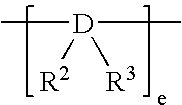Highly flowable 1-butene polymer and process for producing the same
a technology of 1-butene polymer and high flow rate, applied in the field of 1butenebased polymer, can solve the problems of uniformity deterioration of polymers, adverse influence of properties, occurrence of stickiness, etc., and achieve the effect of suitable molecular weight distribution and composition distribution
- Summary
- Abstract
- Description
- Claims
- Application Information
AI Technical Summary
Benefits of technology
Problems solved by technology
Method used
Image
Examples
example 1
(1) Production of Catalyst: Production of (1,2′-dimethylsilylene)(2,1′-dimethylsilylene)-bis(3-trimethylsilylmethylindenyl)zirconium dichloride
[0333]A solution prepared by dissolving 3.0 g (6.97 mM) of a lithium salt of (1,2′-dimethylsilylene) (2,1′-dimethylsilylene)-bis(indene) in 50 mL of THF (tetrahydrofuran) was charged into a Schlenk's bottle, and cooled to −78° C.
[0334]Then, 2.1 mL (14.2 mM) of iodomethyl trimethylsilane was slowly dropped to the solution, and the mixture was stirred at room temperature for 12 h.
[0335]The resultant reaction solution was distilled to remove the solvent therefrom, and then after adding 50 mL of ether thereto, the reaction solution was washed with a saturated ammonium chloride solution.
[0336]An organic phase separated from the solution was dried to remove the solvent therefrom, thereby obtaining 3.04 g (5.88 mM) of (1,2′-dimethylsilylene)(2,1′-dimethylsilylene)-bis(3-trimethylsilylmethylindene) (yield:84%).
[0337]Next, a Schlenk's bottle was charg...
example 2
[0353]An one liter autoclave previously heat-dried was charged with 200 mL of heptane, 200 mL, of 1-butene and 0.5 mM of triisobutyl aluminum, and then hydrogen was introduced into the autoclave until reaching 0.3 MPa.
[0354]After heating the contents of the autoclave to 65° C. while stirring, propylene was further continuously introduced into the autoclave until a total pressure thereof reached 0.8 MPa. Then, 0.8 μM of triphenyl carbenium tetrakispentafluorophenyl borate and 0.2 μM of (1,2′-dimethylsilylene)(2,1′-dimethylsilylene)-bis(3-tri methylsilylmethylindenyl)zirconium dichloride were added to the autoclave, and the polymerization was conducted for 5 min.
[0355]After completion of the polymerization reaction, the resultant reaction product was dried under reduced pressure to obtain 14 g of a 1-butene copolymer.
[0356]The resin properties and physical properties of the thus obtained 1-butene copolymer were evaluated by the above-described methods. The results are shown in Table 1...
example 3
[0357]An one liter autoclave previously heat-dried was charged with 200 mL of heptane, 200 mL of 1-butene, 10 mL of 1-octene and 0.5 mM of triisobutyl aluminum, and then hydrogen was introduced into the autoclave until reaching 0.2 MPa.
[0358]After heating the contents of the autoclave to 65° C. while stirring, 2 μM of triphenyl carbenium tetrakispentafluorophenyl borate and 0.5 μM of (1,2′-dimethylsilylene)(2,1′-dimethylsilylene)-bis(3-trimethylsilylmethylindenyl)zirconium dichloride were added to the autoclave, and the polymerization was conducted for 5 min.
[0359]After completion of the polymerization reaction, the resultant reaction product was dried under reduced pressure to obtain 13 g of a 1-butene copolymer.
[0360]The resin properties and physical properties of the thus obtained 1-butene copolymer were evaluated by the above-described methods. The results are shown in Table 1.
PUM
| Property | Measurement | Unit |
|---|---|---|
| temperature | aaaaa | aaaaa |
| melting point | aaaaa | aaaaa |
| tensile elongation at break | aaaaa | aaaaa |
Abstract
Description
Claims
Application Information
 Login to View More
Login to View More - R&D
- Intellectual Property
- Life Sciences
- Materials
- Tech Scout
- Unparalleled Data Quality
- Higher Quality Content
- 60% Fewer Hallucinations
Browse by: Latest US Patents, China's latest patents, Technical Efficacy Thesaurus, Application Domain, Technology Topic, Popular Technical Reports.
© 2025 PatSnap. All rights reserved.Legal|Privacy policy|Modern Slavery Act Transparency Statement|Sitemap|About US| Contact US: help@patsnap.com



